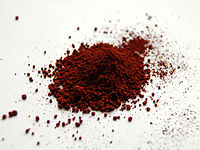
Photo from wikipedia
Abstract Fe3O4/Fe2O3-MIL-101 synthesized using carboxylated Fe3O4/Fe2O3, chromium nitrate nonahydrate, terephthalic acid under microwave irradiation. A new composite, i.e. Fe3O4/Fe2O3-MIL-101-NH2 was also synthesized under microwave irradiation condition. The composites were characterized… Click to show full abstract
Abstract Fe3O4/Fe2O3-MIL-101 synthesized using carboxylated Fe3O4/Fe2O3, chromium nitrate nonahydrate, terephthalic acid under microwave irradiation. A new composite, i.e. Fe3O4/Fe2O3-MIL-101-NH2 was also synthesized under microwave irradiation condition. The composites were characterized with the help of XRD, FT-IR, SEM, EDX, TEM, DSC/TGA and VSM. XRD analysis depicts preservation of iron oxide and MIL-101 peaks in the composite, i.e. Fe3O4/Fe2O3-MIL-101. The transformation of Fe3O4/Fe2O3-MIL-101 to Fe3O4/Fe2O3-MIL-101-NH2 occurred with a decline in the organic content of the product. The EDX analysis depicted the presence of both chromium and iron in both composites. Ferromagnetic nature of both the composites ascertained with the VSM analysis. The Fe3O4/Fe2O3-MIL-101 depicted low adsorption capacity for both cadmium (2.79 mg/g or 41.17 % removal at initial cadmium concentration of 6.8 mg/l) and nickel (1.29 mg/g or 16.88 % removal at initial nickel concentration of 7.7 mg/l). The Fe3O4/Fe2O3-MIL-101 did not show any zone of inhibition with different bacteria during the ecotoxicity study.
Journal Title: Surface Science
Year Published: 2022
Link to full text (if available)
Share on Social Media: Sign Up to like & get
recommendations!